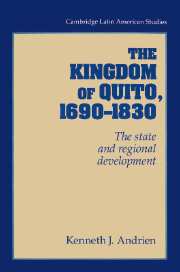Book contents
- Frontmatter
- Contents
- Acknowledgments
- Introduction
- PART I THE STATE AND SOCIOECONOMIC DEVELOPMENT
- PART II REFORM AND POLITICAL CONFLICT
- 7 Political turmoil and economic decline, 1690–1778
- 8 The price of reform, 1778–1830
- 9 Conclusion: the state and regional development
- Appendixes
- Glossary
- Bibliography
- Index
9 - Conclusion: the state and regional development
from PART II - REFORM AND POLITICAL CONFLICT
Published online by Cambridge University Press: 29 September 2009
- Frontmatter
- Contents
- Acknowledgments
- Introduction
- PART I THE STATE AND SOCIOECONOMIC DEVELOPMENT
- PART II REFORM AND POLITICAL CONFLICT
- 7 Political turmoil and economic decline, 1690–1778
- 8 The price of reform, 1778–1830
- 9 Conclusion: the state and regional development
- Appendixes
- Glossary
- Bibliography
- Index
Summary
The major market economies in the Kingdom of Quito – centered on Quito, Guayaquil, and Cuenca – proved incapable of generating ongoing, autonomous growth during the period from 1690 to 1830. The evolution of manufacturing, agrarian, and commercial sectors in these regions was frequently circumscribed by state policies designed to benefit Spain, regardless of their long-term consequences in the kingdom. Colonial governments directed public funds away from local enterprises and sent large amounts of money to support imperial defenses and the needs of metropolitan Spain. Crown taxes, monopolies, and market regulations also hindered growth by siphoning investment capital and savings from productive sectors and by failing to promote an institutional environment capable of maintaining enterprise and economic vitality.
Although deep political divisions emerged after the onset of the independence era in Quito by 1809, the tradition of an activist state survived the breakup of the empire. The newly independent governments of Gran Colombia and later Ecuador merely lacked the power and authority of their colonial predecessor, not the desire to continue public sector interventions. The weakened national regimes transferred wealth abroad, now to repay ill-conceived foreign loans, and continued many of the basic taxes, monopolies, and market regulations that had hindered economic development in the colonial period. Republican states enacted policies that helped to promote weak, divided market economies during much of the nineteenth century.
The state and the market economy
The rugged geography of the north Andes imposed numerous barriers to the growth and integration of regional markets in the Kingdom of Quito. The Andean cordillera and an extensive system of rivers promoted scattered settlement patterns across the narrow mountain valleys, making transportation and communication particularly difficult.
- Type
- Chapter
- Information
- The Kingdom of Quito, 1690–1830The State and Regional Development, pp. 216 - 222Publisher: Cambridge University PressPrint publication year: 1995



